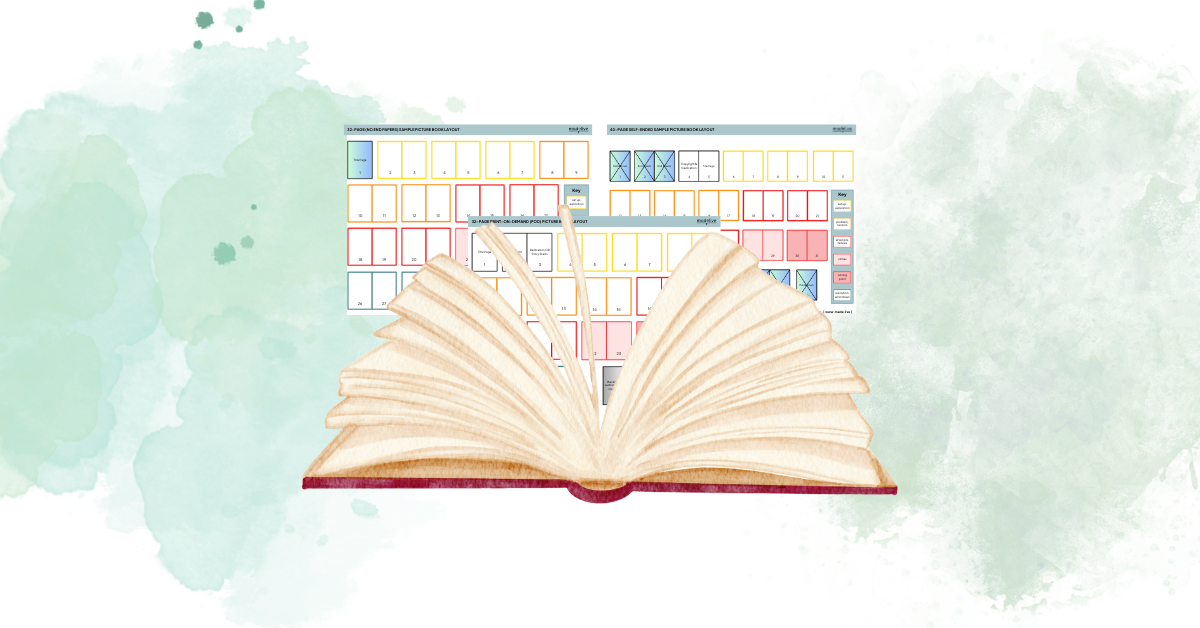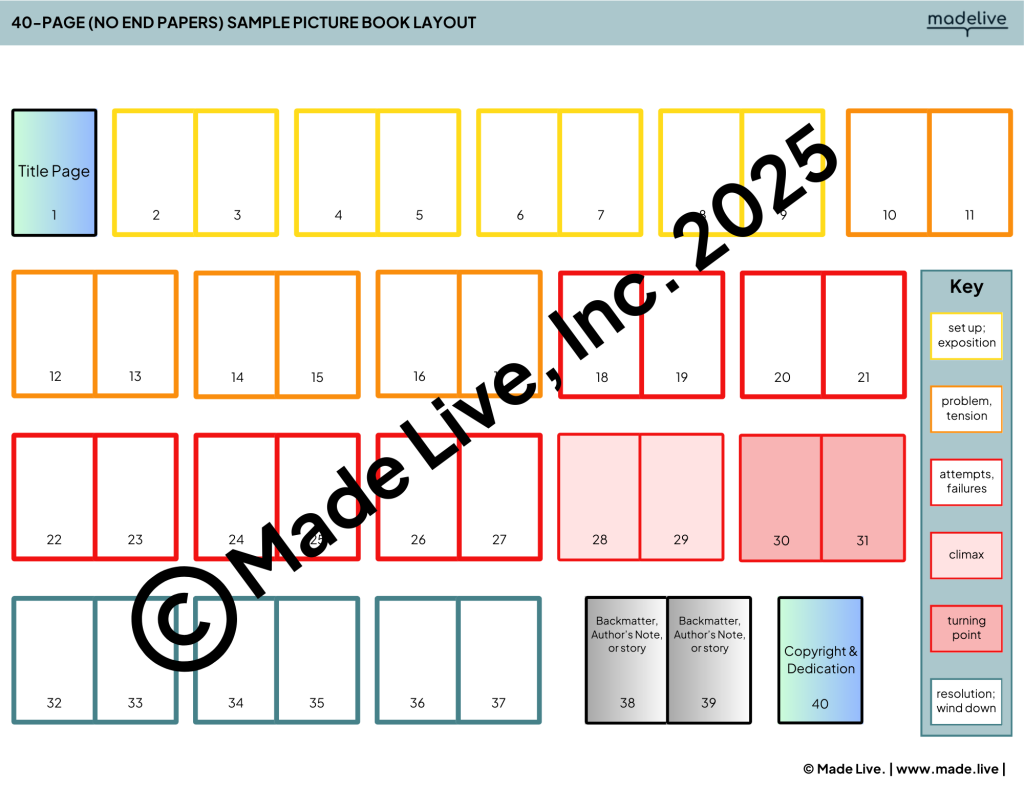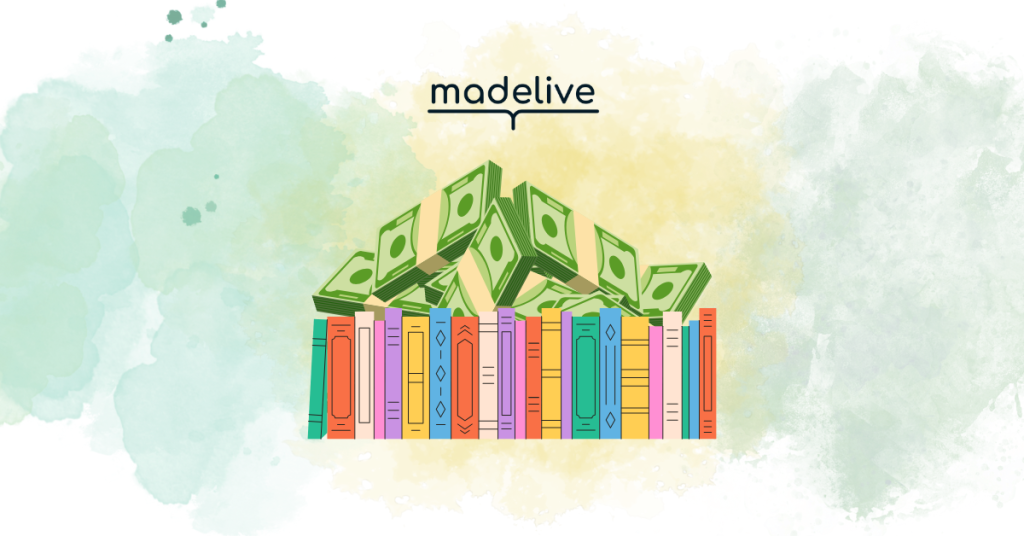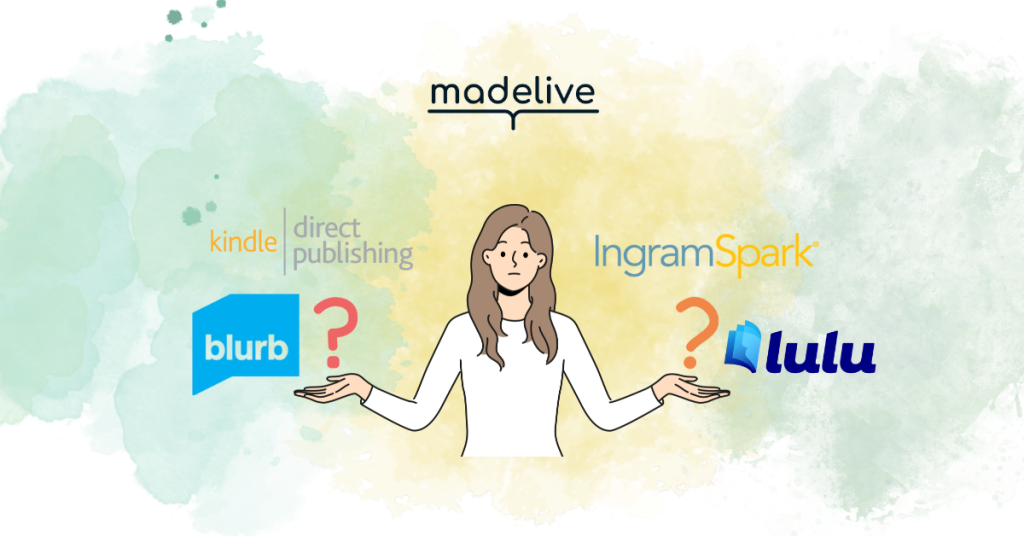Estimated reading time: 8 minutes
Table of contents
- Introduction: Why Picture Book Layout Matters
- Standard Picture Book Formats: 32-Page vs. 40-Page
- The Anatomy of a Picture Book
- Story Structure and Page Allocation
- Frequently Asked Questions: Picture Book Layouts
- How Publishing Paths Affect Your Layout
- Practical Next Steps for Your Picture Book Project
- Take Your Picture Book from Concept to Reality
Introduction: Why Picture Book Layout Matters
Before you write a single word of your children’s picture book, understanding layout fundamentals can save you countless hours of revision and prevent costly formatting mistakes. Whether you’re pursuing traditional publishing or self-publishing, the physical structure of your book directly impacts how you’ll tell your story.
Many aspiring picture book creators dive straight into writing without considering how their narrative will map across pages—only to discover later that their story doesn’t fit the industry-standard format. This cornerstone article will introduce you to essential picture book layout concepts, helping you make informed decisions from the very beginning of your creative journey.
Standard Picture Book Formats: 32-Page vs. 40-Page
Picture books follow specific page count conventions based on how books are physically printed and bound. Commercial printing uses what are called “signatures”—large sheets of paper that, when folded and cut, create 8, 16, or 32 pages at a time.
The 32-Page Format
The 32-page format is the industry standard for picture books, particularly for children ages 4-8. Of these 32 pages:
- Approximately 24-28 pages are available for your actual story
- The remaining pages are reserved for title page, copyright information, and dedication
This format provides enough space for a complete narrative arc while keeping production costs manageable for publishers and self-publishers alike.
The 40-Page Format
The 40-page format offers additional space, generally for the same age group. It is sometimes used for:
- More complex stories with additional plot elements
- Books targeting slightly older readers (6-10)
- Nonfiction picture books that include supplementary information
With a 40-page book, you’ll typically have 30-36 pages available for story content, with the remainder dedicated to front and back matter. This is a popular choice for longer stories that won’t fit on fewer pages.
The Anatomy of a Picture Book
Understanding the components of a picture book helps you plan your content effectively.
Front Matter
These pages appear before your story begins:
- Title page: Displays your book’s title, author/illustrator names
- Copyright page: Contains copyright information, publication details, ISBN
- Dedication page: Optional page for personal dedications (sometimes combined with copyright)
Story Pages
The main section containing your narrative and illustrations, typically beginning on page 3 or 5 depending on your chosen format.
Back Matter
Optional pages at the end that might include:
- Author’s note or letter to readers
- Educational resources related to the book’s theme
- Information about the author and illustrator
- Preview of other books in a series
End Papers and Technical Pages
Picture books may also include:
- End papers: The pages that connect the book block to the cover, which may be decorative or contain story elements
- Paste-down pages: In self-ended books, these pages are glued to the cover and not available for content
Story Structure and Page Allocation
Successful picture books align their narrative structure with page turns to create rhythm, suspense, and emotional impact.
The Classic Picture Book Arc
Professional picture books typically follow this structural pattern:
- Setup/exposition (approximately pages 3-9): Introduce character, setting, and normal world
- Problem/tension (approximately pages 10-13): Present the central conflict or desire
- Attempts/failures (approximately pages 14-21): Show escalating efforts to solve the problem
- Climax (approximately pages 22-25): The moment of greatest tension
- Turning point (approximately pages 26-27): The pivotal moment when things begin to change
- Resolution (approximately pages 28-32): How the story concludes and returns to a new normal
This structure creates a balanced narrative that keeps young readers engaged while providing adequate space for each story element.
We’ve incorporated color coding to our picture book layout templates to show possible distribution options for a classic story arc, as seen below. This is just an example and authors should customize how the story is structured to best serve their unique story.
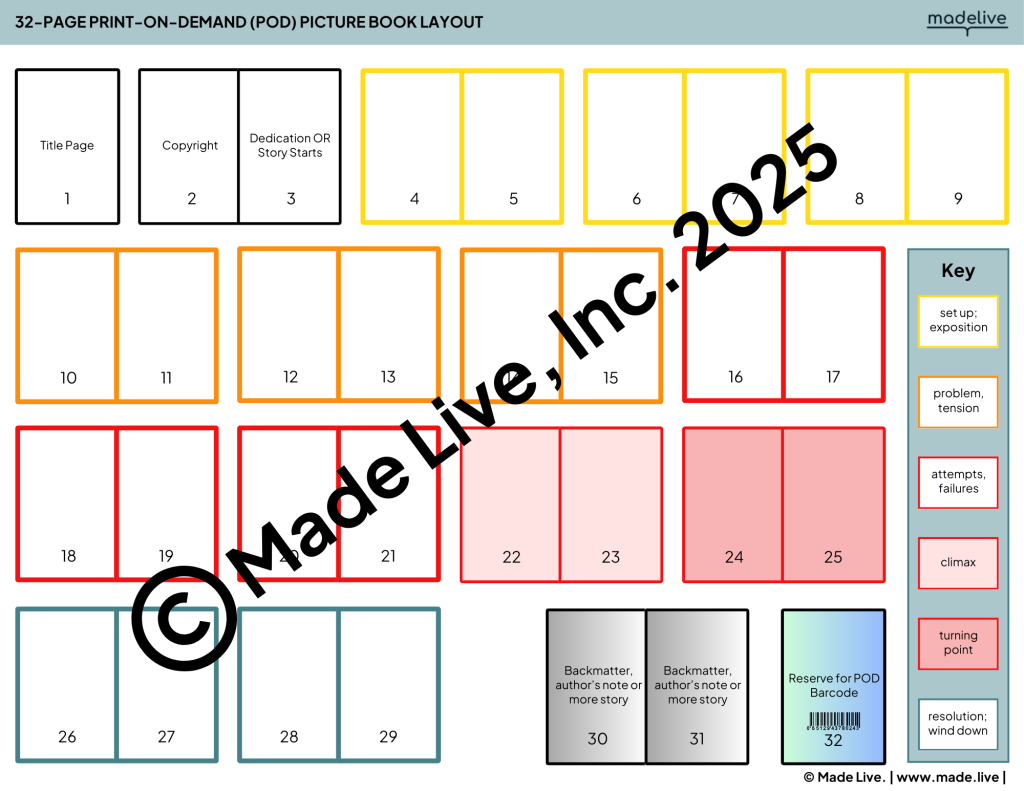
The Power of Page Turns
Picture books have a unique storytelling advantage: the physical page turn. Strategic placement of text and illustrations around page turns creates natural moments of suspense, surprise, or revelation.
Consider these techniques:
- Place questions on right-hand pages, with answers revealed after the page turn
- Build tension leading to a page turn before your climax
- Use page turns to indicate the passage of time or a change in setting
When mapping your story to a layout, think about which moments deserve the dramatic emphasis of appearing after a page turn.
READ MORE: Mastering Page Turns: The Secret Weapon of Successful Picture Books
Frequently Asked Questions: Picture Book Layouts
Picture books come in multiples of 8 pages because of how they’re physically printed and bound. Commercial printers use what are called “signatures”—large sheets of paper that, when folded and cut, create 8, 16, or 32 pages at a time. This production method is most efficient and cost-effective, which is why the standard formats are 24, 32, 40, or 48 pages. Even print-on-demand services maintain these conventions to align with binding equipment specifications and reader expectations.
In a standard 32-page picture book, approximately 24-28 pages are available for your actual story content. The remaining pages are dedicated to the title page (usually page 1), copyright information and dedication (usually page 2), and sometimes back matter (final pages). The exact distribution depends on your publishing path and format choice (traditional, self-ended, or print-on-demand), but generally, you should plan your narrative to fit within 24-28 pages of content.
The climax of a picture book story typically appears around pages 22-25 in a standard 32-page book (or pages 28-31 in a 40-page book). This placement follows the classic picture book structure where approximately 75-80% of the way through the story is reserved for the moment of highest tension or the big revelation. Positioning the climax here leaves adequate space for resolution in the final spreads while ensuring the pacing builds properly throughout the narrative.
To determine whether your story needs a 32-page or 40-page format, consider:
1) Complexity—stories with multiple plot elements or more detailed information may require 40 pages;
2) Target age—books for older picture book readers (6-10) often use 40 pages;
3) Test fitting—create a rough dummy book in both formats to see which accommodates your narrative without feeling rushed or stretched;
4) Publishing path—traditional publishers typically prefer 32-page formats for cost reasons, while self-publishers have more flexibility. If your story feels cramped when mapped across 24-28 content pages, the 40-page format may be more appropriate.
How Publishing Paths Affect Your Layout
Your chosen publishing path—traditional publishing or self-publishing—will influence your layout decisions.
Traditional Publishing Considerations
If you’re submitting to traditional publishers:
- Most prefer the standard 32-page format for debut authors
- Publishers handle technical specifications, but understanding layouts helps you submit appropriate manuscripts
- Story should be structured to fit within approximately 24-28 pages
- Front and back matter will be determined by the publisher
Self-Publishing Options
If you’re self-publishing, you’ll need to make specific technical decisions:
Print-on-Demand (POD):
- Requires space reserved for the barcode, typically on the last page (page 32 in a 32-page book)
- Often places the copyright page on page 2
- Has specific bleed and margin requirements (typically 0.125″-0.25″)
Offset Printing:
- More flexible layout options, including various end paper treatments
- More economical for large print runs (typically 1,000+ copies)
- Allows for special printing features (spot varnishes, foil stamping, etc.)
Understanding these differences helps you plan your book production effectively from the start.
[COMING SOON: Explore our detailed comparison of print-on-demand vs. offset printing specifications]
Practical Next Steps for Your Picture Book Project
With these fundamental layout concepts in mind, you’re ready to take practical steps toward creating your picture book.
- Choose Your Format and Publishing Path
- Based on your story concept, target age range, and publishing goals, decide whether a 32-page or 40-page format is right for your book, and whether you’ll pursue traditional publishing or self-publishing.
- Create a Simple Layout Plan
- Before writing your full manuscript:
- Sketch a basic page-by-page outline
- Note which elements of your story will appear on which pages
- Consider strategic page turns for maximum impact
- Ensure your narrative fits the available content pages
- Before writing your full manuscript:
- Test Your Structure with a Dummy Book
- A dummy book is a simple mock-up that helps you visualize how your story will flow across pages:
- Fold 8 sheets of paper in half to create a 32-page booklet
- Number the pages
- Sketch rough thumbnails and note key text for each page
- A dummy book is a simple mock-up that helps you visualize how your story will flow across pages:
READ MORE: Learn how to create an effective picture book dummy with our step-by-step guide
Take Your Picture Book from Concept to Reality
Understanding layouts is just one piece of the picture book creation puzzle. At Made Live, we offer three pathways to help you transform your story idea into a professionally formatted book:
Made Live Self-Publishing Software Platform
Our specialized software was designed specifically for picture book creators, with built-in templates for every publishing path. Unlike general design tools, Made Live automatically manages correct page counts, proper front/back matter placement, and industry-standard story structure mapping.
Self-Publishing Club
Join our supportive community of creators for 12 weeks of group training masterclasses and feedback on your layouts from industry professionals. Tuition includes a 12 month subscription to Made Live Self-Publishing Software. Perfect for authors who want ongoing support and education.
Join the Self-Publishing Club Waitlist
One-on-One Author Coaching
Work directly with a published picture book author to develop your specific project, with personalized guidance on layout planning, narrative structure, and publishing options.
Book Your Free 15-Minute Consultation
Did you find this article helpful? Share it with fellow picture book creators!
